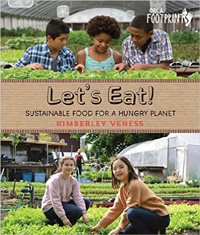| ________________
CM . . .
. Volume XXIII Number 13. . . .December 2, 2016

 |
Let’s Eat! Sustainable Food for a Hungry Planet. (Orca Footprints).
Kimberley Veness.
Victoria, BC: Orca, February, 2017.
48 pp., hardcover, pdf & epub, $19.95 (hc.).
ISBN 978-1-
4598-0939-0
(hc.).
Subject Headings:
Consumption (Economics)-Environmental aspects-Juvenile literature.
Consumption (Economics)-Social aspects-Juvenile literature.
Grades 4-7 / Ages 9-12.
Review by Gillian Richardson.
***½ /4
Reviewed from Advance Reading Copy.
|
| |
|

excerpt:
Grow it on the roof
The city of Hong Kong, China, has over 300 skyscrapers, the most of any city in the world. Seven million people live in Hong Kong and 72 percent of these high rise buildings are residential. Could you imagine if each building was equipped with a rooftop farm capable of producing enough food to feed all of the people living in the building? You could take an elevator up to the roof, pick what you need for dinner and be eating a fresh zero-mile meal minutes later. Yes, please!
Rooftop gardens don’t only provide food, they also purify the air and buffer temperatures. Unlike us, plants breathe in carbon dioxide and exhale oxygen. They are natural air purifiers armed to combat city smog, and they absorb the sun’s rays, leaving the surfaces below them cool. On regular rooftops the sun is absorbed or reflected, adding to what’s called the “urban heat island” effect, where a city is significantly warmer than the surrounding rural areas due to human activities. Have you ever heard of someone frying an egg on the sidewalk on a very hot day? It’s a fun experiment, but it shows how hot manmade surfaces can get. In France, new legislation is making green space or solar panels mandatory on roofs of all new commercial building developments.
It is becoming easier to educate kids about our traditional sources of foods. Farm markets in many communities, school visits to agricultural sites, hands-on activities like releasing newly hatched fish, and even international travel, all provide opportunities to help youngsters understand the human food chain. This book compiles information about some alternate food sources and production methods that will surely play a key role for future generations.
Four chapters divide the well-illustrated book. The first, “Let’s Eat!”, describes current challenges in food production, including distance from markets, use of machinery and chemicals, pollution issues with large production operations. Chapter Two, “Small is Beautiful”, discusses more localized, mainly family owned sources and the methods that work on a small scale. Chapter Three, “Urban Foodscapes”, moves the scene to cities where opportunities for creative growing and distribution turn up, e.g. controlled indoor environments, rooftop gardens and food trucks. The final chapter, “A Farm for the Future”, offers the newer and still controversial (for some) ideas such as insect protein, genetic engineering, and farming in space. This last example brings the book right up to date with what has to work for colonization on Mars to succeed.
The design is inviting, with generous use of quality photos and text presented in small chunks. Additional interesting information in sidebars and photo captions will catch a reader’s eye. “Farming Facts” are suitably brief, but in some cases fewer statistics would be simpler for young readers. “Chew on This!” sections provide an interactive component with suggested activities, like volunteering on a farm, or listing ingredients in your lunch items. Several informative charts appear in the first chapter to translate the labels seen on sustainable seafood, beef and produce—a good way for kids to learn about wise shopping selections.
A list of Resources includes mainly websites and a few adult books. An extensive Glossary with many new terms which are italicized in the text will help the reader while other words are defined in context. An Index will complete the book.
Research by the farm-raised author—and several personal experience notes—shows her passion for the topic. A good deal of detail is packed into this slim book. Frequent use of long, compound sentences, and some mature phrasing bring the reading level quite high for the target audience, however. Some of the subheadings (“In Excess We Trust”; “Permaculture”) are less enticing for kids than others (“Food Truck Fever”; “Green Eggs and Jellyfish”). Presentation of the third chapter is especially interesting and the style more reader-friendly.
Let’s Eat! will add another relevant title to the publisher’s “Footprints” series that offers information about the natural world and our place within it.
Highly Recommended.
Gillian Richardson is a freelance writer living in BC.

To comment
on this title or this review, send mail to cm@umanitoba.ca.
Copyright © the Manitoba Library Association. Reproduction for personal
use is permitted only if this copyright notice is maintained. Any
other reproduction is prohibited without permission.
Next Review | Table of Contents For This Issue - December 2, 2016
CM Home | Back Issues
| Search
| CM Archive
| Profiles Archive
|
